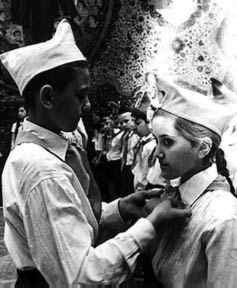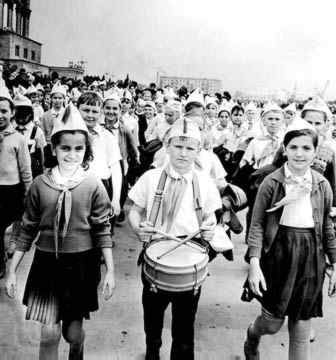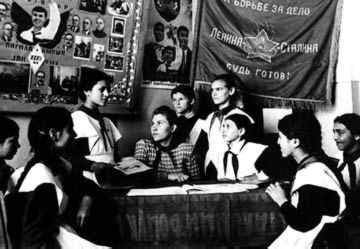
Autumn
1999 (7.3)
No More Red
Pioneer Ties!
Untying
the Soviet Noose Around Our Necks
by Aynur Hajiyeva

 Anyone paying close
attention to the nuance of symbols could have predicted the demise
of the Soviet system several years before it actually happened.
One such indicator was the disappearance of those bright red
Pioneer ties. In a sense, the Pioneer program was the Soviet
equivalent of Boy Scouts and Girl Scouts, except that it was
sponsored by the government and thoroughly integrated into the
school system. Pioneers also served as a preliminary indoctrination
for Communist Party membership, which would follow years later
for the privileged few.
Anyone paying close
attention to the nuance of symbols could have predicted the demise
of the Soviet system several years before it actually happened.
One such indicator was the disappearance of those bright red
Pioneer ties. In a sense, the Pioneer program was the Soviet
equivalent of Boy Scouts and Girl Scouts, except that it was
sponsored by the government and thoroughly integrated into the
school system. Pioneers also served as a preliminary indoctrination
for Communist Party membership, which would follow years later
for the privileged few.
Photo: The long-awaited moment
of receiving the red Pioneer tie, shown here at the Lenin Museum
(1962). National Archives.
In January
1990, almost two years before the official announcement of the
collapse of the Soviet Union (December 1991), Azerbaijan suffered
the dark days of what has become known as "Black January"
when Soviet tanks entered Baku and opened fire, killing hundreds
of innocent civilians. This was Gorbachev's brutal attempt to
crush the independence movement in Azerbaijan. But the plan backfired
and, in fact, served to accelerate the independence movement.
Many of the most devout Communist Party members became disillusioned
and did the unthinkable-set fire to their Party ID cards. It
was a shocking reaction-like severing ties to all of your lifetime
achievements.
It wasn't long before the children also began untying those red
ties from around their necks, disassociating themselves from
the Soviet system as well. Here university student and former
Pioneer Aynur Hajiyeva (1980- ) explains the meaning that was
bound up in those pieces of red cloth that now are so obsolete.

Pioneer ties
were the ultimate status symbol for kids like me. The ties were
simple triangles of red cloth made out of some sort of nylon
material that was forever wrinkling. But they soon took on deeper
levels of association for us. They were our initiation into the
power of symbols.
Being a Pioneer
was the second step up the ladder to becoming a member of the
Communist Party. Children in Grades 1-4 were called "Octobrists"
(October refers to the 1917 Bolshevik Revolution in Russia).
By Grade 5 when most students were about 10 years old, the brightest
and best were invited to become "Pioneers".
National
Archives Photos - Left: Pioneers parade in Lenin Square in Baku on the
occasion of Lenin's 94th birthday (1964).

Eventually everyone
in the class would sport the red ties, but this was our first
taste of hierarchy in a society that touted egalitarianism.
Between Grades
8-10, everybody became Komsomols. Eventually, at the final stage,
some were invited to enter the privileged world of the Communist
Party.
National
Archives Photos - Left: Pioneers meeting at Baku's school No. 64 (1951).
Most kids didn't become Pioneers until they were 10 or 11 years
old. I was seven because I had started school early and had also
skipped a grade. Nevertheless, I was the first student in my
class chosen to be a Pioneer. I considered it my first major
achievement in life. As I look back, I'm sure my teachers used
me as an example to prod the other kids, "Look how young
and studious she is. She's a Pioneer. Study hard and you can
be one, too!"
Becoming a Pioneer was really a big deal. Our inaugural ceremony
was held in the schoolyard. How tall and straight we tried to
stand-just like soldiers. We had practiced our military salutes
with swift precise movements, positioning our hands at just the
right angle. I remember taking the solemn oath to become a Pioneer:
"Here in
the presence of my classmates,
In the presence of my Pioneer leader,
And my Motherland,
I make this oath.
I am becoming a Pioneer.
I promise not to do anything
that would blemish the name of the Pioneers.
I'll be brave.
I'll help my friends when they're in trouble.
I'll study well.
I'll try to do my best for my Motherland.
I'll always protect my Motherland."
And then, the long-awaited moment came when my Pioneer leader
put the red tie around my neck-I was so proud. I remember how
I never wanted to take it off. I would go strutting around and
showing it off to everyone, especially when I first got it.
Whenever I went for a walk with my father, he would ask, "Isn't
it too hot for you to wear that?" I would reply, "No,
not at all," Never mind the scorching heat, I didn't want
to take it off-ever!
There were so many rules to follow. The right tip had to extend
down further than the left tip. I can't remember exactly what
that was supposed to mean, but we had to strictly observe it.
My tie was always slipping around my neck. My Pioneer leader
would fuss at me: "Do you think you're a cowboy? Look like
a real Pioneer! Adjust your tie!" I would do my best to
fix it, but never managed to succeed for long.
I remember how the material used to wrinkle so easily. If a single
drop of water accidentally got on the tie, it would bleed and
leave a stain, making it look like you hadn't washed it for ages.
Most Pioneers washed and ironed their ties every night.
We wore our ties to school every day without exception. I'll
never forget: once I was late and just as I was running into
the school building, I realized: "Whoops! No tie."
I was just about to race out the door and home again when the
Pioneer leader caught me.
"Where's your Pioneer tie?" she scolded. She would
accept no excuse. "No matter what happens, you must never
forget your tie! Go and write a composition about Lenin's life.
Make it at least two pages long." I was seven years old
at the time.
So I ran home, tears streaming down my face. It had been an innocent
mistake but I felt ashamed. I had simply been in a hurry and
forgotten my tie. Luckily, I found a composition I had already
written about Lenin for one of my classes. I grabbed it, put
on my tie and ran back to school again.
Eroding Faith
Our fascination with ties didn't last long. We were growing up
in the 1980s and our country was beginning to take its first
steps toward independence. Beginning in 1988, there were massive
demonstrations held in Lenin Square (now "Freedom"
or "Azadlig Square").
For the first time, our parents and teachers began to complain
about the difficulties of the Soviet period. They dared to tell
us that the Russians were not really our friends, and that our
country needed to get out from under the oppressive rule of what
was, in truth, the Russian Empire in the guise of the "Soviet
Union".
We had never heard such things before. We had grown up with slogans
like "Lenin is great. He is our grandfather." I still
remember some of the poems dedicated to Lenin's memory.
"With red
flags in our hands,
We are fighting on the path that Lenin made.
We are fighting,
We are working on the path that Lenin made for us."
Needless to
say, we didn't fully understand the content of the poems. Another
poem was more symbolic.
"Let there
be sun forever.
Let there be sky forever.
Let there be my mother forever,
And I will be forever."
The sun, of
course, meant the Soviets and mother meant Motherland. The poem
seemed simple, but its meaning was deeper. We gradually began
to understand its symbolism.
We had classes where they taught us "Soviet History"-that's
what they called it, but really it was Russian history. The other
14 republics were barely ever mentioned. What happened in the
other 14 republics before the Soviets took over? What about Azerbaijan?
We were denied the right to know our own history. For example,
we were never taught that Yerevan (now Armenia) used to be populated
mostly by Azerbaijanis. As far as the history of Azerbaijan was
concerned, they only told us about the prehistoric period.
After the Black January tragedy of 1990, everyone understood
Russia's true position toward us. The relationship and trust
had been destroyed. Our country went into mourning for 40 days.
Classes were canceled. Black flags and strips of black cloth
hung everywhere-from cars, windows, trees-to remind us of our
people who had been so viciously murdered by the Soviet troops.
Officially, 156 had died in the attack. A more accurate figure
might be 500.
When classes finally resumed, I wasn't sure if I should still
wear my red tie or not. I started wondering: "Why should
I wear this red tie? What does the Soviet system have to do with
me? How could they kill their own people?"
I decided to ask our Pioneer leader: "Do we have to wear
these ties anymore, now that the Soviets are treating us so badly?"
Her answer was very revealing. She paused and then confessed,
"You know, I'm not sure."
In the past, if I had posed such a bold question, she would have
yelled at me, "What are you talking about? What's your problem
with wearing it? Oh, I can't believe you! Of course you have
to wear it!"
But this time, her uncertainty could not be hidden. "We'll
talk about it later," she told me.
Here was our Pioneer leader-a woman who had held such a strong
belief in our country-and now her own confidence and trust in
the system had been shaken. Her hesitation signaled that something
was dreadfully wrong. Even a child could figure that out.
No More Ties
No one told us to stop wearing the ties when we returned to school.
It just happened gradually. One day, two students showed up not
wearing them; the next day, three more. That's the way it went
until before long, the majority of students had stopped wearing
them.
I continued wearing mine for awhile but then I stopped. No one
ever asked: "Why aren't you wearing your red tie today?"

 Even though we were
very young, we understood that the ties around our necks were
more than red pieces of cloth. They had become nooses that strangled
our own identity and our own security and safety.
Even though we were
very young, we understood that the ties around our necks were
more than red pieces of cloth. They had become nooses that strangled
our own identity and our own security and safety.
Some Pioneers burned their red ties; others threw them away.
I just took
mine off and set it aside. I think it's in a pile of old clothes
somewhere. I'm not exactly sure anymore. It seems so long ago
and far away.
Aynur Hajiyeva is
in her final year of studies in linguistics at the Azerbaijan
State Institute of Languages. She is a member of the Editorial
Staff of Azerbaijan International magazine.
Home
| About
Azeri | Learn
Azeri | Arabic
Script | Store | Contact
us
Articles from Azerbaijan
International
© Azerbaijan International. Copyright 2002. All rights reserved.
|
|
 |
Pioneer ties were the ultimate status symbol for kids like me. The ties were simple triangles of red cloth made out of some sort of nylon material that was forever wrinkling. But they soon took on deeper levels of association for us. They were our initiation into the power of symbols. Being a Pioneer
was the second step up the ladder to becoming a member of the
Communist Party. Children in Grades 1-4 were called "Octobrists"
(October refers to the 1917 Bolshevik Revolution in Russia).
By Grade 5 when most students were about 10 years old, the brightest
and best were invited to become "Pioneers". |
 |
Eventually everyone in the class would sport the red ties, but this was our first taste of hierarchy in a society that touted egalitarianism. Between Grades 8-10, everybody became Komsomols. Eventually, at the final stage, some were invited to enter the privileged world of the Communist Party. National Archives Photos - Left: Pioneers meeting at Baku's school No. 64 (1951). |
Most kids didn't become Pioneers until they were 10 or 11 years old. I was seven because I had started school early and had also skipped a grade. Nevertheless, I was the first student in my class chosen to be a Pioneer. I considered it my first major achievement in life. As I look back, I'm sure my teachers used me as an example to prod the other kids, "Look how young and studious she is. She's a Pioneer. Study hard and you can be one, too!"
Becoming a Pioneer was really a big deal. Our inaugural ceremony was held in the schoolyard. How tall and straight we tried to stand-just like soldiers. We had practiced our military salutes with swift precise movements, positioning our hands at just the right angle. I remember taking the solemn oath to become a Pioneer:
"Here in
the presence of my classmates,
In the presence of my Pioneer leader,
And my Motherland,
I make this oath.
I am becoming a Pioneer.
I promise not to do anything
that would blemish the name of the Pioneers.
I'll be brave.
I'll help my friends when they're in trouble.
I'll study well.
I'll try to do my best for my Motherland.
I'll always protect my Motherland."
And then, the long-awaited moment came when my Pioneer leader
put the red tie around my neck-I was so proud. I remember how
I never wanted to take it off. I would go strutting around and
showing it off to everyone, especially when I first got it.
Whenever I went for a walk with my father, he would ask, "Isn't
it too hot for you to wear that?" I would reply, "No,
not at all," Never mind the scorching heat, I didn't want
to take it off-ever!
There were so many rules to follow. The right tip had to extend
down further than the left tip. I can't remember exactly what
that was supposed to mean, but we had to strictly observe it.
My tie was always slipping around my neck. My Pioneer leader
would fuss at me: "Do you think you're a cowboy? Look like
a real Pioneer! Adjust your tie!" I would do my best to
fix it, but never managed to succeed for long.
I remember how the material used to wrinkle so easily. If a single
drop of water accidentally got on the tie, it would bleed and
leave a stain, making it look like you hadn't washed it for ages.
Most Pioneers washed and ironed their ties every night.
We wore our ties to school every day without exception. I'll
never forget: once I was late and just as I was running into
the school building, I realized: "Whoops! No tie."
I was just about to race out the door and home again when the
Pioneer leader caught me.
"Where's your Pioneer tie?" she scolded. She would
accept no excuse. "No matter what happens, you must never
forget your tie! Go and write a composition about Lenin's life.
Make it at least two pages long." I was seven years old
at the time.
So I ran home, tears streaming down my face. It had been an innocent
mistake but I felt ashamed. I had simply been in a hurry and
forgotten my tie. Luckily, I found a composition I had already
written about Lenin for one of my classes. I grabbed it, put
on my tie and ran back to school again.
Eroding Faith
Our fascination with ties didn't last long. We were growing up
in the 1980s and our country was beginning to take its first
steps toward independence. Beginning in 1988, there were massive
demonstrations held in Lenin Square (now "Freedom"
or "Azadlig Square").
For the first time, our parents and teachers began to complain
about the difficulties of the Soviet period. They dared to tell
us that the Russians were not really our friends, and that our
country needed to get out from under the oppressive rule of what
was, in truth, the Russian Empire in the guise of the "Soviet
Union".
We had never heard such things before. We had grown up with slogans
like "Lenin is great. He is our grandfather." I still
remember some of the poems dedicated to Lenin's memory.
"With red
flags in our hands,
We are fighting on the path that Lenin made.
We are fighting,
We are working on the path that Lenin made for us."
Needless to say, we didn't fully understand the content of the poems. Another poem was more symbolic.
"Let there
be sun forever.
Let there be sky forever.
Let there be my mother forever,
And I will be forever."
The sun, of
course, meant the Soviets and mother meant Motherland. The poem
seemed simple, but its meaning was deeper. We gradually began
to understand its symbolism.
We had classes where they taught us "Soviet History"-that's
what they called it, but really it was Russian history. The other
14 republics were barely ever mentioned. What happened in the
other 14 republics before the Soviets took over? What about Azerbaijan?
We were denied the right to know our own history. For example,
we were never taught that Yerevan (now Armenia) used to be populated
mostly by Azerbaijanis. As far as the history of Azerbaijan was
concerned, they only told us about the prehistoric period.
After the Black January tragedy of 1990, everyone understood
Russia's true position toward us. The relationship and trust
had been destroyed. Our country went into mourning for 40 days.
Classes were canceled. Black flags and strips of black cloth
hung everywhere-from cars, windows, trees-to remind us of our
people who had been so viciously murdered by the Soviet troops.
Officially, 156 had died in the attack. A more accurate figure
might be 500.
When classes finally resumed, I wasn't sure if I should still
wear my red tie or not. I started wondering: "Why should
I wear this red tie? What does the Soviet system have to do with
me? How could they kill their own people?"
I decided to ask our Pioneer leader: "Do we have to wear
these ties anymore, now that the Soviets are treating us so badly?"
Her answer was very revealing. She paused and then confessed,
"You know, I'm not sure."
In the past, if I had posed such a bold question, she would have
yelled at me, "What are you talking about? What's your problem
with wearing it? Oh, I can't believe you! Of course you have
to wear it!"
But this time, her uncertainty could not be hidden. "We'll
talk about it later," she told me.
Here was our Pioneer leader-a woman who had held such a strong
belief in our country-and now her own confidence and trust in
the system had been shaken. Her hesitation signaled that something
was dreadfully wrong. Even a child could figure that out.
No More Ties
No one told us to stop wearing the ties when we returned to school.
It just happened gradually. One day, two students showed up not
wearing them; the next day, three more. That's the way it went
until before long, the majority of students had stopped wearing
them.
I continued wearing mine for awhile but then I stopped. No one
ever asked: "Why aren't you wearing your red tie today?"

![]() Even though we were
very young, we understood that the ties around our necks were
more than red pieces of cloth. They had become nooses that strangled
our own identity and our own security and safety.
Even though we were
very young, we understood that the ties around our necks were
more than red pieces of cloth. They had become nooses that strangled
our own identity and our own security and safety.
Some Pioneers burned their red ties; others threw them away.
I just took
mine off and set it aside. I think it's in a pile of old clothes
somewhere. I'm not exactly sure anymore. It seems so long ago
and far away.
Aynur Hajiyeva is
in her final year of studies in linguistics at the Azerbaijan
State Institute of Languages. She is a member of the Editorial
Staff of Azerbaijan International magazine.
Home
| About
Azeri | Learn
Azeri | Arabic
Script | Store | Contact
us
Articles from Azerbaijan
International
© Azerbaijan International. Copyright 2002. All rights reserved.